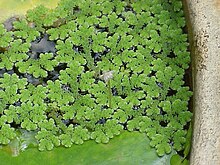
Back أزولا Arabic ازولا ARZ Азола Byelorussian Azolla Catalan Azolla CEB Azola Czech Algenfarne German Azolo (planto) Esperanto Azolla Spanish آزیریان Persian
| Azolla Temporal range:
| |
|---|---|

| |
| Azolla caroliniana | |
| Scientific classification | |
| Kingdom: | Plantae |
| Clade: | Tracheophytes |
| Division: | Polypodiophyta |
| Class: | Polypodiopsida |
| Order: | Salviniales |
| Family: | Salviniaceae |
| Genus: | Azolla Lam.[1] |
| Type species | |
| Azolla filiculoides[1] | |
| Species | |
|
See text | |
| Synonyms | |
| |
Azolla (mosquito fern, duckweed fern, fairy moss, water fern) is a genus of seven species of aquatic ferns in the family Salviniaceae. They are extremely reduced in form and specialized, looking nothing like other typical ferns but more resembling duckweed or some mosses. Azolla filiculoides is one of just two fern species for which a reference genome has been published.[2] It is believed that this genus grew so prolifically during the Eocene (and thus absorbed such a large amount of carbon) that it triggered a global cooling event that has lasted to the present.[3]

Azolla may establish as an invasive plant in areas where it is not native [where?]. In such a situation it can alter aquatic ecosystems and biodiversity substantially.[4]
- ^ a b In: Encyclopédie Méthodique, Botanique 1(1): 343. 1783. "Name - Azolla Lam". Tropicos. Saint Louis, Missouri: Missouri Botanical Garden. Retrieved February 19, 2010.
Annotation: a sp. nov. reference for Azolla filiculoides
Type Specimens HT: Azolla filiculoides - ^ Li, Fay-Wei; Brouwer, Paul; Carretero-Paulet, Lorenzo; Cheng, Shifeng; de Vries, Jan; Delaux, Pierre-Marc; Eily, Ariana; Koppers, Nils; Kuo, Li-Yaung (July 2, 2018). "Fern genomes elucidate land plant evolution and cyanobacterial symbioses". Nature Plants. 4 (7): 460–472. doi:10.1038/s41477-018-0188-8. ISSN 2055-0278. PMC 6786969. PMID 29967517.
- ^ Speelman, E. N.; Van Kempen, M. M. L.; Barke, J.; Brinkhuis, H.; Reichart, G. J.; Smolders, A. J. P.; Roelofs, J. G. M.; Sangiorgi, F.; De Leeuw, J. W.; Lotter, A. F.; Sinninghe Damsté, J. S. (March 2009). "The Eocene Arctic Azolla bloom: environmental conditions, productivity and carbon drawdown". Geobiology. 7 (2): 155–170. Bibcode:2009Gbio....7..155S. doi:10.1111/j.1472-4669.2009.00195.x. PMID 19323694. S2CID 13206343.
- ^ Weber, Ewald (2017). Invasive Plant Species of the World: A Reference Guide to Environmental Weeds. p. 65. ISBN 9781780643861.
© MMXXIII Rich X Search. We shall prevail. All rights reserved. Rich X Search